How Much of Paul Stamets Work Is Peer Reviewed
Leaf Litter
Skilful Q&A: Paul Stamets
Mycologist, author, and visionary Paul Stamets talks near fungi's game-changing potential for our profession…and our planet.
Mycologist and author Paul Stamets has spent more than than iv decades studying, cultivating, experimenting with, and writing about fungi. In the process, he has unearthed some promising and powerful mycological strategies for addressing today's ecology, public wellness, and food security challenges. He has discovered several new species of mushrooms, and pioneered countless techniques in the field of mushroom cultivation
Commodity Index
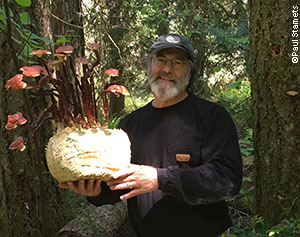
Paul Stamets with avariant of the Reishi mushroom (Ganoderma lucidum s.l.)
In 1980, Paul foundedFungi Perfecti, LLC, a family-owned business dedicated to promoting the tillage of high quality gourmet and medicinal mushrooms. His customers include not only gardeners, cultivators, and nutritionists, but as well ecological researchers and managers.
Paul's work in mycology has been recognized by numerous national organizations. In 2008, he received the National Geographic Adventure Magazine's Greenish-Novator Award as well every bit the Argosy Foundation'south E-chievement Awards. He was also named ane of Utne Reader's "l Visionaries Who Are Changing Your World" that same year. In Feb 2010, Paul received the President'south Award from the Northwest Chapter of the Order for Ecological Restoration for contributions to habitat restoration. In 2014, he received the highly acclaimed NAMA (North American Mycological Association) Award for expanding the field of mycology. Selected as an "Invention Ambassador" by the American Clan for the Advocacy of Science, Paul was also the first-ever recipient of the Mycological Society of America'due south Gordon and Tina Wasson Honor.
Paul has written vi books and numerous articles and papers on fungi. His books Growing Gourmet and Medicinal Mushrooms and The Mushroom Cultivator (coauthor) have long been hailed every bit the definitive texts of mushroom cultivation. In his 2005 book Mycelium Running: How Mushrooms Tin Aid Save The World, and his 2008 TED Talk, " 6 ways mushrooms can save the earth," which has garnered nearly iii.viii 1000000 views, he presents some compelling prove of fungi'due south game-changing potential for our planet and species.
Can yous briefly tell us about the function of fungi in evolution?
Fungi are the principle agents of terraforming. They were the beginning organisms to come to land more than 500 million years agone. Fungi paired with algae to form lichens. Many fungi partnered and evolved with plants, which allowed plants to march onto country. Most people are surprised to learn that fungi swallow rocks. Fungi produce networks of cells called mycelium. These mycelial networks digest rocks. When they practise, they liberate minerals, which are upward-channeled via the roots of plants. Of course mycelium also digests plants and dead animals. They are the grand recyclers of Nature. In doing and then, they regulate food pathways to literally all organisms on land. And at present at that place is testify they as well are significant part of the ecology of ocean sediments.
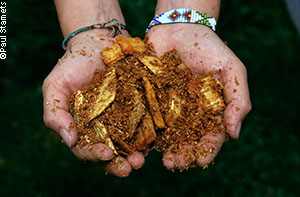
Wood fries
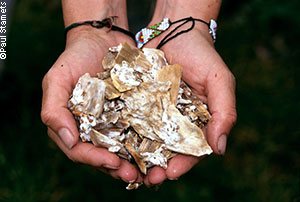
Wood chips colonized by mycelium
Fungi are agents of alter that run on the margins between ecosystems. They are edge runners. Their skill sets let them to answer to ecological catastrophes, and for very good reason. A lot of the nutrients in nature are locked up, but when a stick or limb is broken, fresh surface areas are exposed, and readily colonized by competing networks of fungal mycelia. Because of the myco-diversity of fungi in the ecosystem, there is aggressive contest for that newly available niche of nutrient. This has led to amazing groups of fungi that can capture plant and animal material equally shortly as information technology is rendered available. Through the procedure of decomposition, they spin off all sorts of nutrients that enable and empower successions of other organisms.
A simple visual of this can be seen at our facility, where we grow tons of mushrooms a month. Afterwards the mushrooms are produced, the substrate becomes very appetizing to worms. Worms and other organisms – including bacteria and other fungi – then come up into this complex dance, and within just three or four months, harbinger or sawdust is rendered into a cute, compost-rich soil.
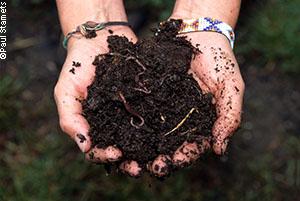
A uncomplicated visual of this tin be seen at our facility, where we grow tons of mushrooms a month. Afterward the mushrooms are produced, the substrate becomes very flavory to worms. Worms and other organisms - including bacteria and other fungi - then come into this complex dance, and within just three or iv months, straw or sawdust is rendered into compost-rich soil
It is estimated that at that place are ii to three million species of fungi on Globe. Near 150,000 of these species are mushroom-forming, meaning that yous tin see the reproductive structure with the naked heart. Of the 150,000 mushroom forming fungi, we have just identified 14,000 species and then far. This means that over xc% of the mushroom species out there in nature take not been identified. At that place is concern that we could be losing species faster than we can discover them. Similar rivets in an airplane, how many will we lose until we jeopardize ecological sustainability?
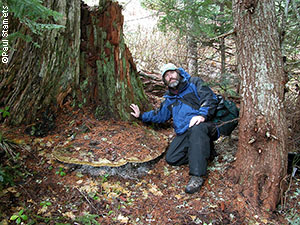
What practise nosotros know nearly the status of fungi worldwide? Are there known endangered fungi, and are fungi species tracked on the IUCN Red List?
There are endangered fungi, and they practice announced on the IUCN Cerise Listing. I have written about Bridgeoporus nobilissimus, a large polypore that grows exclusively in old growth forests (run into "The Ancient Noble Polypore (Bridgeoporus nobilissimus): A Mushroom of Many Mysteries"). The common proper noun is the Fuzzy Sandozi fungus, and I can share an interesting story about how it got that name. Dr. Daniel Stuntz, a mycologist from the University of Washington, was visiting George Weyerhaeuser, the president of Weyerhaeuser, a huge logging and paper products visitor. Stuntz noticed a huge polypore shelf mucus, about iii to four feet in bore, on Weyerhaeuser's drapery, and he asked Weyerhaeuser where he had gotten it. Weyerhaeuser replied that loggers known every bit the Sandozi brothers had establish information technology in an old growth forest and gave it to him as a gift. That mushroom turned out to be a new species, and it was incredibly rare. There are 6 or 8 locations in Oregon and Washington where this fungus grows today, and those areas cannot be cut.
Can yous briefly describe the main categories of fungi and the role(southward) that each plays in terrestrial ecosystems?
All habitats are infused with fungi. These mycelial networks–the fine, sparse strands that are literally underneath every footstep you take—are the construct of the nutrient spider web. There are four master groups of fungi operating in the ecosystem, and nosotros can accept a tree as an example to explain them.
First, there are mycorrhizal fungi, which are associated with the roots of the tree. Mycorrhizal fungi can either exist ectomycorrhizal, meaning they grow around the outside of plant roots, or endomycorrhizal, significant they grow inside the institute roots by invading the interior root cells. Mycorrhizal fungi take mutually beneficial relationships with the institute. The roots of the tree secrete sugars to reward the fungi, and the fungi pass essential minerals to the tree, which let it to grow. Ectomycorrhizal fungi also aggrandize the rhizosphere of the tree, massively extending the absorption zone and increasing the power of the soil to retain water.
Endophytic fungi are nonmycorrhizal fungi that literally grow within of all plants, parallel to and in between the plant cells. Classically, they were called "pathogenic," but nosotros now know that endophytic fungi profoundly enhance the immune systems of plants. There can exist several hundred endophytic fungi species within one good for you tree. This vast, complex consortia of fungal species strengthen the tree'southward resistance confronting pathogens, parasitic fungi, and predatory insects. A tree is not fully alive; much of its mass is expressionless or dormant tissue. Endophytic fungi accept a clever relationship with the tree: they support its allowed system while exploiting its dead tissue when information technology becomes available.
Parasitic fungi, which live off of a host plant and endanger its health, can impale the tree. Retrieve of it like wolves culling a herd. Those that are not equally potent are deselected out of the gene pool. [In his book, Mycelium Running, Stamets states that although parasitic mushrooms are stigmatized as blights upon plants, they may actually be "nature'southward manner of selecting the strongest plants and repairing damaged habitats."]
When a tree dies, saprophytic fungi come into play. Saprophytic fungi are the decomposers. They are the premier recyclers on the planet because they build soils every bit they decompose dead plants, insects, and other animals. There are crossovers betwixt endophytic and saprophytic fungi. These are categories that humans have created trying to empathise the language of nature.
There are waves of mycelium running through ecosystems that are across our sight. About xxx% of salubrious soil is composed of organisms, living and dead. The bulk (70%) of those organisms by biomass are fungi. It is amazing how blind nosotros have been to the importance of fungi when they are the master biological class of organisms that give rise to healthy soils.
Why have we been so blind? Because fungi are out of view?
Yes, and considering of this, studies of fungi are underfunded and underappreciated. We suffer from what has been termed "mycophobia," an irrational fearfulness of fungi. In our day-to-day, yr-to-yr activities, we have common, often daily, encounters with plants and animals. Mushrooms, on the other hand, may come up up and disappear within v days once a year, and sometimes non seen for many years. Some are edible, delicious, and important as nutrient. Some are medicinal. Some tin can get you high and send you lot on a spiritual journey. Some tin can kill you. They are so strong, yet and then temporal from our perspective. We humans take a much greater comfort level with that which is familiar than with that which is strange. Overcoming the strangeness of fungi is intellectually enervating. You must learn what species are salubrious and which ones can damage you lot. However, we have now raised our level of consciousness to the point where we can showtime digging deeper into the fabric of nature, and when we do so, we find that fungi are at the very forefront.
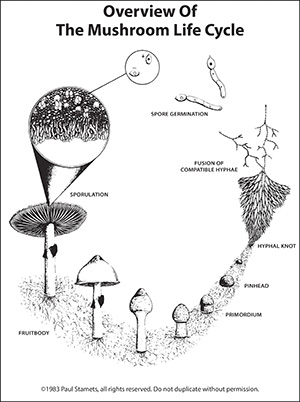
Exercise mycelial networks exist in ecosystems with inundated or saturated soil? If so, what role do they play in those ecosystems?
Fungi are constitute throughout marshlands. In fact, there is an entire field of marsh mycology. Many species of fungi are saline tolerant. All grasses have endophytic fungi, and saprophytic fungi help the continuity of marshlands over long periods of time because they are extremely proficient at recycling nutrients.
Fungi are everywhere. It was recently reported that the largest face-to-face membranes of fungi on World are in the oceans, at the interface between the hardpan rock and the sediment layer above. Mushroom mycelium are aerobic organisms, but they can tolerate extremely high carbon dioxide levels; far across that which nosotros could survive. So the ecosystems of the ocean are also benefitting from the recycling ability of saprophytic fungi. Many of us mycologists expressed surprise at first, so thought 'only of course!'
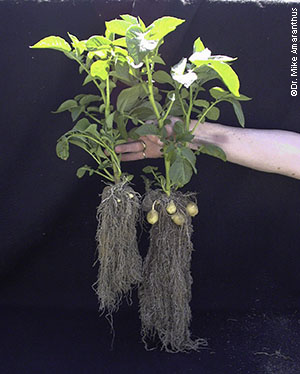
Potatoes grown with (R) and without (l) mycorrhizal spores
Could fungi play a role in sustainable agriculture?
Absolutely. Fungi take evolved cooperatively with plants for millions of years, and this partnership has immune plants to receive nutrients. The problem with modern agriculture is that our plants have become addicted to fertilizer, and more recently, to chemical treatments that suppress weeds. Considering of phosphates and GMOs, we at present have highly fond plants whose natural nutrient cycles accept been supplanted.
In a sense, our plants accept become drug addicts. Rather than relying on their natural allowed systems and exercising their ability to get nutrients out of their ecosystems, they are being spoon fed chemicals. The result is that the soil quality is degraded and the plants are chemically dependent. Moreover, mycelium is the immune organisation of these ecosystems. With their food and immune systems weakened, the plants go highly susceptible to disease. Factory farming and monocultures exacerbate the problem. The consequences are reverberating throughout the world.
I wrote an unabridged chapter on "Permaculture with a Mycological Twist" in my book, Growing Gourmet and Medicinal Mushrooms. The use of benign fungi to attain sustainable agronomics in permaculture practices is in the forefront. All permaculture scientists and activists I know are very neat in promoting the use of fungi to bolster the allowed system of crops.
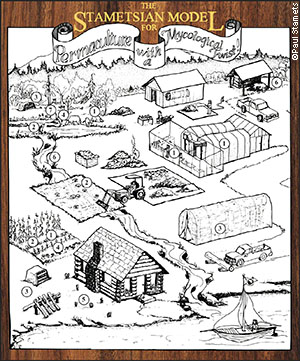
Many of our readers are involved in restoring ecosystems, which tin can mean a disturbance of soil during structure. How should practitioners have mycelial networks into consideration when they must disturb soil?
Fungi – with their mycelia – are some of few organisms that benefit from disturbance. When you break it up, the mycelium forks and splinters into many other filaments from its tips equally information technology grows. This provides more than surface area for expressing enzymes. Simply the mycelium must be fed. If y'all disturb the soil, I recommend adding wood chips and sawdust to the soil. The species of forest you add is of import, and you should plain include indigenous tree species. You should not add redwood and cedar, every bit they accept antifungal compounds that will tiresome the growth of fungi. Deciduous woods such as cottonwood, alder, aspen, and poplars are very quick to decompose. Hardwoods such equally oaks also piece of work well. Most conifers are besides useful. Non surprising, fungi have adjusted to compose the majority of tree species

Aquarium filled with soil, cardboard and harbinger and inoculated with Stropharia mycelium.
When storms have downwardly tree limbs, nature is subsidizing the food for mycelium. By rotting forest, fungi empower ecosystems past surging nutrients throughout the mural. Therefore, adding more than food to mycelium after disturbance volition non only cause a burst in growth of the mycelium, information technology builds up the carbon banking concern in the soil. Nature needs fractal complexity at varying states of decomposition, because that creates all these niches for organisms to accept up residence. That's why I always say, "Don't export the dead wood off your property. Allow it rot!" The biodiversity in the ecosystem is the biosecurity for the food spider web, and you lot tin can't get at that place with a monoculture.
What practice we know about the presence of mycelial networks in heavily paved, urbanized areas?
Every urban center garden has mycelium, and every tree planted along a sidewalk has mycelium. Wherever there are plants, at that place are mycelial networks. Road engineers long agone discovered that you lot must become down to "mineral earth," where at that place is no organic debris, before you put down asphalt or concrete. Mushrooms are notorious for causing millions of dollars of damage past breaking through concrete and cobblestone. It'southward crazy. You lot can crumble mushrooms in your hand, notwithstanding they take these Herculean forces that are so powerful they tin can break through concrete and asphalt!
Beyond including mycorrhizae in soil specifications, what communication can you lot offering to practitioners involved in ecological restoration?
We have lots of mycological members in our biological toolkit. Practitioners need to consider which member has the skill set most appropriate to address the upshot at manus.
In 1984, I purchased a pocket-sized farm on the Skookum Inlet, a saltwater inlet that is a run for salmon and steelhead, and a place where clams and oysters are commercially grown. My farm had cows, chickens, and pigs. I was there for about 2 weeks, when a sheriff showed upwardly to serve me a summons. Due to upland pollution from farms and failing septic systems, Eastward. coli was threatening native fish runs and the commercial interests of the shellfish growers. My belongings was identified as a point source of pollution, and I was given ii years to put in a certified, inspected septic system or I would be physically removed from the property. I decided to put in a 200-foot long swale of woodchips, about a foot deep, which I inoculated with the Garden Giant mushroom mycelium (Stropharia rugoso annulata).
A year later, a fleet of authorities vehicles showed upwards. They said, "Paul, we've been monitoring all of the inflows into Skookum Inlet from the upland backdrop. Did yous put in a septic arrangement?" I said, "no." Although my bio-burden had greatly increased considering my amount of livestock had more than than doubled by then, the goverment officials reported that the water from my property had a hundred-fold or greater reduction in East.coli contagion.
I and then received a Washington State Department of Ecology grant to conduct testing on the myceliated woodchip beds. Unfortunately, during testing we had thirteen inches of pelting in one day! This blew out my beds, and so our experiment failed because of a freaky natural phenomenon. Many years afterwards, we received an $85,000 EPA grant to examination mycofiltration using these mycelial membranes, and we showed that nosotros could dramatically reduce E. coli flowing through stormwater or wastewater.


Stropharia rugoso-annulata with woodchip/straw medium being tested to see if it can remove E. coli from flowing water
One of the peer reviewers was concerned nigh tannins that might be emitted into the ecosystem from the wood chips. Nosotros went back and did parallel tests, putting water through naked wood chips versus wood chips that were covered with mycelium from the Garden Behemothic. Lo and behold, the wood chips that were covered in mycelium massively reduced the tannins. [SEE PHOTO} Nosotros constitute that mycelium not merely removes E.coli and captures a lot of nitrogen, but it also breaks downwardly the woods chips and confers microfiltration benefits that we are still discovering.
The Garden Giant mushroom is a great mushroom for everyone involved in ecological restoration. It grows anemically in a sterile lab environment, but when information technology hits the soil, it has a tremendous appetite for bacteria, and its mycelia –forming thick white ropey rhizomorphs-run like crazy. They capture the wood chips and get a biological filter. Not only does this fungus eliminate E.coli as the mycelia eat it as a food source, its mushrooms are likewise perfectly edible, and tin counterbalance upwardly to 5 pounds per specimen. As a decomposer, it can as well quickly turn woodchips into rich soil. It is one of the species in our mycological toolkit that is at the very forefront for restoration and for cleaning upwardly stormwater and subcontract waste.
I recall information technology besides contributes to the importance of riparian ecosystems. I was originally trained equally a marine biologist, and I one time had to raise 20 coho salmon (Oncorhynchus kisutch) fingerlings sourced from a fishery hatchery in Washington State. I put them in a stainless-steel tank, merely I didn't know what to feed them. It merely so happened that the Garden Giant mushroom was fruiting. When these mushrooms get large they attract fly larvae, and maggots kickoff growing in them. I was desperate to feed the fish, then I threw the mushrooms in the tank and I waited for well-nigh 45 minutes. The mushrooms swelled with water, maggots started coming out of them, and the salmon became like piranhas. They darted later on the larvae, consuming them, specially after colliding with the mushrooms to knock the larvae out. I ended that in a riparian ecosystem, these fungi not only aid capture deleterious bacteria, excessive nitrogen, and phosphorous, but they also provide food for fish. Litter from trees feeds the mycelium that grows the mushrooms; the mushrooms attract flies that create larvae; and the larvae then wash into streams and feed the fish. At present in China, tilapia and trout hatcheries feed mushrooms and mycelium to fish and have found it prevents bacterial diseases while strengthening the immunity of the fish.

oyster mushrooms (Pluerotus spp)
Is the Garden Giant the "go-to" tool in the mycological toolbox for people involved in ecological restoration?
Several primary species rise to the forefront when it comes to ecological restoration. The Garden Giant is a terrestrial mushroom, and one time you establish it, information technology wanders around your property and goes wherever droppings fields are available. Information technology tin can stay resident in your ecosystem for many, many years.
Oyster mushrooms (Pleurotus ostreatus spp.) quickly decompose forest and straw, but they tend to be more temporary. They stay resident for around six months, so they are a quick gear up. They are extremely powerful at breaking down hydrocarbons like oil, herbicides, pesticides, and insecticides. The molecules of lignin, the fibrous substance in woody tissue, are held together with carbon-hydrogen bonds. Mycelium produce enzymes, which interruption those bonds in lodge to swallow the woods, and those same bonds concur hydrocarbons together. As oyster mushrooms secrete enzymes to assimilate wood and hydrocarbons, they remanufacture those hydrocarbons into fungal carbohydrates, or sugars.

In research that I conducted with Battelle Laboratories , nosotros used fungi to pause down Bunker C oil roughly equal in concentrations to that which was inflicted onto the beaches in Alaska by the Exxon Valdez spill. We were able to reduce hydrocarbons from 20,000 ppm to less than 200 ppm in about xvi-18 weeks. This was an extraordinarily powerful example of how these fungi can break downwards toxins. Keep in listen that hydrocarbon-saturated environments are extremely express in species variety. These toxins in the ecosystem prevent and so many organisms from growing. Yet, these mushroom-forming species are gateway species: they tin break down the toxins and reduce the adversarial hurdles that limit biodiversity. Once our pile was mycoremediated, a plethora of plant species emerged, with increasing biological variety, without whatever detected smell of oil. The control, untreated piles and the piles treated with bacteria and enzymes remained dead, nighttime and stinky.
What other toxins are fungi proving to be effective at breaking downwards?
They tin intermission down most insecticides, including Dichloro-diphenyl-trichloroethane. They can too break downwardly PCBs, to varying degrees. In addition, fungi also can be trained to break a substance down. During some of my piece of work with the Department of Defence force and Battelle, nosotros discovered that we could train two species of mushroom-forming fungi to pause down the neurotoxin VX. We challenged 28 species by giving them VX as the sole nutrient source, and out of these 28 species, two of them were trained to intermission down this neurotoxin. It took u.s.a. almost four months of stepwise increasing the corporeality of VX and decreasing the corporeality of natural nutrients. The end of this experiment showed that the 2 species adapted their enzymatic digestive juices to use VX as their sole nutrient source. Fungi are highly adaptable to toxins in the surround, and they tin can elaborate unique enzyme suites targeted specifically to the challenges that they meet in the ecosystem.
Your work has shown that excerpt of the mycelium from the agarikon mushroom (Fomitopsis officianlis) , a difficult woodconk polypore, can assistance protect human claret cells from the family of viruses that includes smallpox. The agarikon's habitat, old growth wood, is in rapid decline. Has knowledge well-nigh the office of fungi in public health brought new audiences into the habitat conservation chat?
Absolutely. By far, my greatest recent discovery is that I call back I take found a style to save bees from colony collapse disorder. Just yesterday, we got more inquiry results on polypore mushroom reducing viruses in bees. Through our research and tests with the USDA and Washington Country University, we have found that extracts of the mycelium of agarikon, reishi (Ganoderma lucidum), chaga (Inonotus obliquus), amadou (Fomes fomentarius)—all polypore mushrooms that grow in the wood—dramatically reduce the viruses considered to be the main cause of colony collapse disorder. Other causes include loss of habitat, malnutrition, neonicitinoids, glyphosates and insecticides, but five primary articles in 2016 scientific literature identified viruses vectored by the Varroa mite equally beingness the principal cause of colony collapse disorder. All bees analyzed by UDSA laboratories specializing in bee viruses now take these viruses. This includes native bees.

Dusty Yao and (Fomitopsis officinalis)
I have quite a few patents on this at present. My research has all been authenticated by tiptop-notch laboratories such every bit NIH Virology, U.S. Department of Defense, USDA, and multiple universities. A friend who I met through TED, Lee Stein, observed from afar and so closely, and he was my greatest supporter in moving this research forward, helping finance some of these studies through non-profit foundations. The fact that these polypore mushrooms reduce viruses that harm bees, people, birds, and pigs leads me to recollect I have establish something cardinal to the foundation of nature: that the mycelium of these mushrooms is office of the immunity of our ecosystem. Equally nosotros deforest the ecosystem, we're dismantling the very food sources that give ascension to these mycelial networks and maintain the immunity of the ecosystem'southward inhabitants. We are dismantling the very fabric of nature — the immunological networks that mycelium provide. At that place is a crossover of interspecies benefit from the antiviral properties of these mushrooms.
How much attention is coming to this now with your recent work?
I was approached by the MacArthur Foundation to put in an application for their 100&Modify Grant. This is a $100 1000000 grant to fund a unmarried proposal from a unmarried person for a prototype-shifting, scalable solution that tin be globally implemented. Maybe I don't have a snowball's run a risk in hell, merely I don't know of anything more important that is at disquisitional mass now than losing the biosecurity of our food networks because of colony plummet disorder. And colony collapse is accelerating – nosotros may lose commercial pollination within x years unless we can find a solution or at least slow down these trends.
How and when volition these fungal solutions to colony collapse disorder be applied?
We are in hives right now. We are working with Washington State University and other universities, and are scaling upwardly as rapidly every bit we can. We take reproduced these results four times in three different laboratories and now accept had success outdoors in the field. The solutions are easily deployable.

All commercial beekeepers feed their bees sugar water, and we introduce an extract of the mycelium into the bees' sugar h2o. Yous but add ~ i% of these extracts to the saccharide water and in that location are dramatic effects. The extract not only reduces viruses, but extends the bees' longevity. On October 25th I received a U.S. patent on this thought, and I have filed international patents likewise, including an Australian patent, which was just issued. Provided I can afford to do so, my promise and intent is to open source this patent for global benefit. Your readers can stay upward to date past visiting my spider web site, fungi.com.
What led you to probe the possible connection between fungi and colony collapse disorder?
I was growing the Garden Behemothic mushroom in my garden, and one day in 1984, I noticed a continuous convoy of bees going from my bee hives to my garden giant mycelial patch. For 40 days, from dawn to sunset, I kept a notebook on it. I reported it in Harrowsmith magazine in 1988, and in one of my books in 1994, but and then I basically forgot about it. I had assumed the bees were attracted by the sweet sugars being emanated by the mycelium. Then it dawned on me that the bees may demand the mycelium for immune benefit or for detoxification pathways.

Paul, with bees
These extracts piece of work because in that location is a synchronicity of benefits on five dissimilar levels. Five dissimilar pathways synergistically come together.
- Mycelium exudes carbohydrate rich extracellular metabolites in the class of sweet droplets that feed bees
- Mycelial exudates confer antiviral benefits
- Mycelial exudates have antibacterial properties
- Mycelial exudates have within them p-coumaric acids which actuate the cytochrome p450 detoxification pathways, turning on the 47 or so genes in bees that are essential for detoxification.
- Mycelium produces oxalic acrid crystals that impairment Varroa mites
How did you become interested in fungi in the first identify?
I was very shy and I always stared at the ground, and then I found fossils and…. mushrooms at an early age. I get-go got into fungi because I accept e'er been attracted to that which is forbidden. When I was a young boy, I would throw puffball mushrooms at my twin blood brother, and their spores would explode out of the puffball upon impact. One day my mother came running out into the grand saying "Don't throw puffballs at your blood brother! The spores volition make him bullheaded!" This is not truthful, merely I thought "This is good information. Thank you, Mom!" and I pelted my brother with as many puffballs as possible!

The hallucinogenic properties of Amanita muscaria have been known for centuries
I have had a severe stuttering habit ever since I was a child. Stutterers of my type practise non stutter to animals or when we sing, merely we stutter when we talk to people. When I was around 17 years old, I bought a bag of magic mushrooms. I didn't' know how much to take, so I causeless the whole bag was a single dose. I knew from reading The Natural Mind past Dr. Andrew Weil that the setting of my trip was important, then I went out to the countryside and consumed the mushrooms.
I went to a behemothic tree on top of the highest loma in the expanse. The mushrooms started coming on quite apace and I idea, "I'll climb to the top of this tree then I tin take a good view." There was a lightning storm on the horizon. In that location were roiling black clouds, rolling thunder, and darts of lightning. It was very visually rich. I saw fractal patterns in the lightning — geometry I had just read about before, not seen. The tempest came closer and closer, just I couldn't get out of the tree because I had consumed also many mushrooms and was experiencing vertigo. I hugged the tree, and information technology became my Axis Mundi, anchoring me to the earth. Suddenly the rains came, and there were lightning strikes all around me. It was a terrifyingly interesting feel. I realized I could die up in that location. At that moment, I said to myself, "If I survive, I'one thousand going to larn something from this experience." I thought about what the biggest problem was in my life, and past far, it was my inability to communicate because of my stuttering. So I started repeating the mantra "Stop stuttering now. Stop stuttering now," in between lightning strikes. I must have said it hundreds of times. Fortunately, I did not get struck by lightning.
Later, I climbed out of the tree, walked dwelling, and went to bed. The next morning, I encountered a young lady I had been attracted to. She was kind, just well-nigh women are more attracted to self-assured, confident young men. I saw her coming, and instead of staring at the ground as she approached me, I looked straightforward. My eyes met hers and she said, "Expert morning, Paul." I said "Good morning" back- without stuttering. I had stopped stuttering in one 24-hour interval. (Though I'll acknowledge that when I met Bill Gates, I stuttered, and if I drinkable too much alcohol and I'thou in a noisy bar, I can nonetheless stutter.)

mycelium 500X
Studies out of Johns Hopkins University and the University of Southern California show that psilocybin, the psychedelic chemic in Psilocybe mushrooms, allows for neurogenesis, the regeneration of neurons. These studies show that under the influence of psilocybin, you lot can actually re-pattern the flow of data through neurons, and eliminate the fright response. I likewise believe these substances within mushrooms increase intelligence. They help overcome our fears. They strengthen our resolve to become braver while remaining compassionate. These are all traits that give ascent to leadership. So my feel in the tree at age 17 was a N of 1 (N=one) report has now been partially medically authenticated. Mushrooms have been central and of import to my life ever since.

Stropharia
Any final words for our readers?
Our solutions must be ecologically rational. Fungi present a unique suite of implementable, ecologically rational solutions that could be put into the forefront. Run with mycelium! The mycelial path we share will reveal remarkable solutions. This is a path that we must share with all peoples, and for all generations. The Kickoff Peoples had it right with the concept of Seven Generations. At present we accept the ecological tools for helping that vision succeed, we can overcome the many challenges nosotros all face during these stressful times. But we must respect, larn and use nature. We are all in this together.
Sign upward for Leaf Litter
Browse by topic
Browse past year
Source: https://www.biohabitats.com/newsletter/fungi/expert-qa-paul-stamets/


0 Response to "How Much of Paul Stamets Work Is Peer Reviewed"
Enviar um comentário